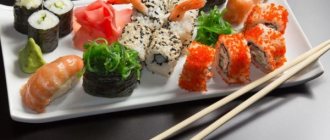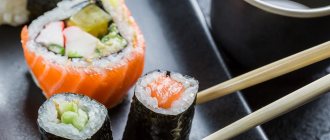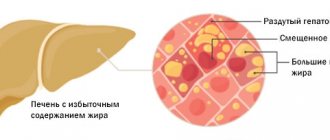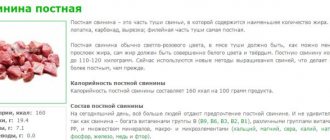It is difficult to meet a person who has never tried sushi. People who adhere to vegetarian views have completely replaced meat with rolls. All over the world, traditional cuisine of Asian countries is associated with health and eternal youth, and is considered light and dietary.
In 2021, scientists found that the exotic dish is not so healthy. Experts conducted experiments on the purity of ingredients in the best establishments around the world. As a result, seven reasons were identified why it is better to give up sushi!
Low quality fish sushi
Fish is good for the body: it is full of vitamins and microelements, and fish oil is a natural food supplement. But this fact applies only to fish that are caught in the seas and oceans.
In the restaurant business, food purchases are made at low prices. Salmon, tuna and other types of fish that are bought by restaurants are grown on artificial fish farms. “Children” of farms are much more harmful than natural ones for several reasons:
- in production, fish receive a huge dose of antibiotics;
- salmon and tuna are fed with special feed;
- The water in the pools is rarely changed, so the fish defecate and live in the same water for a long time.
When ordering sushi at home via the Internet, you cannot see what kind of fish is used during preparation. There is no certainty that the fish is 100% fresh, especially if it has been smoked or baked (so-called “hot sushi”).
Healthy sushi recipes
Don’t forget that you can prepare sushi and rolls at home with a lot of useful properties. Below you will find recipes that will allow anyone to prepare a dish at home that will be beneficial and not harmful.
Sushi Maki
Ingredients:
- 500 g rice for making sushi;
- 6 pieces of seaweed;
- 1 cucumber;
- 3 carrots;
- 1 avocado;
- 1 lemon;
- 3 tbsp. l. rice vinegar;
- 2 tbsp. l. brown cane sugar;
- 1 tbsp. l. salt;
- wasabi packaging;
- soy sauce and pickled ginger.
Cooking method:
- The first step is to thoroughly rinse the rice. Afterwards, place the rice in a saucepan and add water so that there is 20% more water than rice.
- The lemon should be cut into 2 halves, one of which should be placed in a pan with rice, and the other should be left for now.
- Pre-mixed rice vinegar, sugar and salt should be added to the pan with rice.
- Next, cover the rice with a lid and cook over high heat until half cooked. Then you need to remove the lemon and continue to cook over low heat. After 10 minutes, remove the pan from the heat and leave to cool.
- The cucumber must be peeled and cut into thin strips. A bamboo napkin is wrapped in cling film. Squeeze the juice from the second half of the lemon into a small bowl and dilute it with water.
- Place a piece of nori on a napkin, shiny side down.
- Place the rice on the seaweed, moistening your hands with water and lemon. Lightly grease the rice with wasabi and place cucumber, avocado and carrots on it.
- Using a napkin, roll the seaweed away from you. It is necessary to roll the rolls as tightly as possible. When the seaweed is completely rolled up, you need to trim off the sloppy edges and cut into 5-6 pieces. Serve with wasabi and soy sauce.
Sushi California
The California method of preparing sushi is not fundamentally different from the Maki recipe. The idea is that after applying rice to the noria, you need to turn the layer over with the rice facing down. In this case, first sprinkle the surface on which the rice will subsequently fall with sesame seeds.
Attention! Some of the seeds can be lightly fried in a frying pan, thanks to which the properties and taste of the seeds will change.
After turning the noria over, lightly smear it with wasabi and then proceed according to the Maki recipe.
A portion of mercury and arsenic
Fish may contain dangerous substances: mercury and arsenic. The harm of these chemicals to the human body has been known for a long time.
- Mercury harms the immune, nervous and digestive systems, negatively affects the eyes, kidneys, lungs and skin, including death.
- Arsenic is a poison. When poisoned, all organs are affected, but especially the nervous and digestive systems. It is worth noting that arsenic not only disrupts the functioning of organs and systems, but also affects cellular development and processes.
Vegetables and seaweed
Just like good quality fish, you can’t find fault with vegetables. To prepare rolls, cucumbers are most often used, which have virtually no calories, and avocados are a source of fatty acids, vitamins, potassium, copper, iron and many other minerals. It turns out that vegetables are completely beneficial and no harm to your figure. Dried nori seaweed also does not pose any danger: it contains a lot of iodine, iron, and fiber.
What to eat without harming your figure? 10 most delicious low-calorie dishes
You don't even have to give up pasta and desserts.
Marine parasites
These are the most common helminths that infect fish and many other seafood.
Marine parasites, especially if diagnosed too late, can cause serious health problems, ranging from headaches to cancer. Externally, fish and seafood infected with parasitic pathologies are no different from healthy ones.
You can protect fish by freezing it at a temperature of -40 degrees for 3 hours. However, in this case its taste characteristics will be lost, so this practice practically does not occur. According to the rules of Japanese cooking, fish that has not undergone any processing is put into rolls and sushi.
The history of sushi and its types
Sushi appeared at the beginning of the 7th century. But in those days they didn’t eat rice, and sushi was made from fish, which was previously marinated with rice. In South Asia, fish were cleaned, cut into pieces and layered with boiled rice. Next, the components were tightly placed in the prepared container and a pressure in the form of a stone was placed on top. This method made it possible to preserve fish throughout the year. When the time came, the rice was thrown away and the fish was eaten.
In the 17th century, fish began to be eaten with rice. At the same time, various seasonings were often added and rolls were made. In the 19th century, sushi began to be made with raw fish, which made it possible to cook it before eating right in front of customers.
Nowadays, the use of rolls has spread far beyond Japan, and their health benefits and harms are of interest to many.
The difference between rolls and sushi is that sushi consists of thin plates of fish fillet, seafood and rice. Rolls also include other products. There are many types of rolls in modern cooking. Let's consider the most popular:
- California roll, prepared with shrimp, chaplain caviar and Japanese omelette;
- Philadelphia roll with tobiko caviar, salmon and cream cheese;
- hosomaki and monorolls, their properties differ in that the outside is wrapped in seaweed, and the filling contains rice, fish fillet or some kind of seafood.
We recommend reading: The benefits of goat cheese
As for sushi, the most popular are:
- nigiri sushi, the classic recipe of which consists of a piece of rice topped with fresh fish fillet;
- futomaki sushi, its special property is that the seaweed is located on the outside and the shape is cylindrical;
- Nared-sushi, today it is made in a special form, with fish fillet and rice laid out in layers.
Harmful Ingredients
Sushi and rolls are incomplete without white rice and soy sauce. Unfortunately, the sauce contains a high percentage of sodium. It causes problems with the cardiovascular system. A person's blood pressure rises and the risk of a heart attack increases.
Soy sauce is prepared according to a complex recipe. The price of real soy sauce is several times higher than the price of the liquid that many are used to seeing in restaurants. Unscrupulous manufacturers do not follow the traditional recipe, adding GMOs and other harmful ingredients to the sauce. Soy sauce can be replaced with coconut aminos.
Taking the harmful ingredients even further, white rice is rich in refined carbohydrates. The body spends entire reserves of useful substances and energy on their processing. In addition, carbohydrates cause allergies and liver problems.
Contraindications, harm
Despite the undeniable beneficial properties of sushi and rolls, their use is associated with a number of dangers:
- Tuna fillet contains mercury and other heavy metals, since this marine predator lives long enough and comes into contact with polluted waters of the World Ocean.
Attention: Tuna should not be consumed more often than once every 3-4 weeks. It is also contraindicated in pregnant women and children under 10 years of age.
- Red fish are one of the strongest allergens.
- Raw seafood is often contaminated with tapeworms and roundworms, which die only when very deep frozen (-18°C).
- Real Japanese wasabi is replaced with cheap types of horseradish with the addition of aromatic additives and artificial colors.
- The iodine content in nori seaweed is quite high, and its excessive consumption can cause problems with the thyroid gland.
- In regions far from seas and oceans, raw fish meat becomes a source of harmful bacteria - the conditions for freezing, storage and delivery deep into the continent are often not met, and thawed fish fillets very quickly become unusable.
- Soy sauce contains large amounts of concentrated sodium chloride. Excess salt causes swelling, disrupts the flow of fluid from the body, is deposited in the form of stones, and also provokes arthritis and gout. Moreover, this product is not always natural, as some manufacturers include chemical additives and acids in it.
When eating sushi, you must also remember about individual intolerance to the ingredients. Allergy sufferers and people with peptic ulcers of the gastrointestinal tract are prohibited from eating such dishes. It is not recommended for people with diabetes to eat them due to the high glycemic index of rice.
Imitation wasabi
As journalists from The Washington Post write, the wasabi in many local restaurants has little in common with real wasabi in Japan. Many sushi markets, under the guise of wasabi, put nothing more than ordinary horseradish with green dye and mustard.
The imitation wasabi comes in large industrial packages as a powder, and before serving it, chefs dissolve the powder in water to form a simple hot paste. Why is that? Everything is logical: one kilogram of the real rhizome of the plant from which it is prepared costs at least 120 dollars per kilogram! This is an uncompetitive price.
The main diet of the Japanese
The Japanese eat traditional rolls on special occasions. The main place in the Japanese diet, one might say, belongs to noodles, which are served as hot dishes, soups, chilled with sauces. A huge share of the country's noodle consumption comes from the instant product, invented by Momofuku Ando in 1985 in Japan.
A popular dish is ramen, which is ordinary noodles in soup. It is prepared today in a variety of variants. Changes in variations may concern the broth itself, prepared on the basis of salt, miso, soy sauce, ending with various fillers. Everything will depend on where you eat.
Thus, you don’t have to eat rolls every day, but if you want to join Japanese cuisine, its diversity will allow you to choose exceptional dishes suitable for daily consumption!
The material was prepared by specialists from Sushi “Sushnyak” https://su-sushi.ru/
breeding ground for bacteria
Research has been conducted in Norway. The results shocked scientists: out of 100% of samples, 71% were found to contain bacteria dangerous to the body. They can cause problems with the intestines, skin and general health.
Scientists identified temperature disturbances during transportation as the main reason for the low quality of fish. Even slight warming leads to the appearance of bacteria. If you eat sushi made from fresh fish, there is a high chance that you will get dangerous bacteria along with your food.
Are there parasites in sushi?
Perhaps the most important and pressing problem. Most people believe that by eating raw fish sushi, a large number of parasites enter the human body. Sushi or any dish that is made from raw ingredients or that has been slightly cooked can become contaminated with dangerous bacteria.
It should be understood that sushi stored for a long time or improperly can lead to a number of gastrointestinal diseases. Sushi is a potential source of helminths, tapeworms and opisthorchis. Remember that the shelf life of sushi should not exceed no more than 5-6 hours . Most people believe that eating sauces or wasabi destroys harmful substances. But alas, this is not so and they do not solve this problem.
Healthy alternatives to sushi and rolls
There are healthy alternatives to sushi and rolls. They will cause minimal harm to health and will be much tastier than a traditional Japanese dish.
- Making your own rolls. You will be able to purchase products for the rolls yourself and will be confident in their authenticity and freshness.
- At restaurants, ask for brown rice instead of white. It is much healthier than traditional rice.
- Eat rolls with vegetables. They are safer than red fish.
- Skip the wasabi. Leave only the ginger, it is much healthier than fake wasabi.
- Don't use soy sauce. It can be replaced with coconut amino acids. They have less sodium and enhance the flavor of the rolls.
- Sashimi is fish without rice or sauce. You won't get a ton of substances that are useless for the body. There is a risk of harm from stale fish, but it is minimal.
By giving up sushi and rolls, you really limit the risk of poisoning from dangerous ingredients! What do you think about this? Write in the comments.
Can sushi be dangerous? How not to make a mistake with your choice. We answer popular questions
Sushi is a delicacy that has gained popularity in many countries, including ours. Residents of Moldova love to treat themselves to this dish in sushi bars and restaurants. But do we know everything about this dish?
What is the secret of sushi's popularity?
Exoticism
We are always attracted to everything unusual. Fish served this way is not our traditional dish, and it’s not food that we cook every day, and we can’t always afford it, so we haven’t gotten tired of it yet. The exoticism of products, their combination, involvement in another culture, the same bamboo sticks, and not the usual forks - these are the main factors that together attract us.
Innings
The healthiest summer vegetables and fruits: what and how to eat for health
As you know, a beautiful presentation is the main marketing ploy, especially in the age of smartphones, when “you meet people by their clothes.” Externally, the dish looks aesthetically pleasing to us, especially in sets, boats, and other original presentations from restaurants, which is why so much attention is paid to sushi and rolls on social networks. As you know, for a dish to be successful, it must first be “eaten” with the eyes.
Lack of spices
Another feature is the lack of spices. Salt, pepper and other spices sometimes “confuse” taste buds, preventing you from experiencing the true taste of dishes.
The Japanese practically do not allow too much spice in their dishes. To add a piquant taste or spiciness, they use dressings that refresh the taste buds between servings of sushi or rolls. This is wasabi or pickled ginger. They are characterized by a special aroma and taste, so they are always consumed separately.
Is sushi high in calories?
It all depends on the filling. Diet food lovers can choose rolls with cucumber or other vegetables. For those who don’t count calories and love delicious sea fish, you can order rolls with several types of fillings, for example, “California” or “Philadelphia”.
- calorie content of salmon sushi - up to 128 kcal (proteins 6–9 g, fats 3 g and carbohydrates 15–19 g);
- calorie content of sushi with cucumber - 90 kcal (proteins almost 2 g, fats 0.7 g and carbohydrates 19 g);
- for sushi with eel, calorie content can range from 173 to 204 kcal (proteins up to 7 g, fats 8–13 g, carbohydrates up to 19 g);
- vegetarian sushi - calorie content approximately 133 kcal (proteins 3 g, fats 1 g and carbohydrates 35 g);
- baked sushi - calorie content 216 kcal (proteins 8 g, fats 5 g, carbohydrates 26 g).
Large companies often order a sushi set, the calorie content of which depends entirely on the composition. The set may include rolls with various filling options, as well as classic-shaped products consisting only of rice and a certain type of fish.
How many calories are in California sushi?
These rolls are one of the most famous in the world. The classic recipe for the dish is filled with crab meat, avocado and cucumber, wrapped in nori seaweed. The whole thing is surrounded by a layer of rice, and the outside of the roll is tightly covered with a layer of tobiko caviar.
Calorie content of California sushi is about 176 kcal per 100 g (7 g protein, 9 g fat and 17 g carbohydrates). A standard serving contains 6 pieces of 28 g each. Therefore, for this type of sushi the calorie content is 1 piece. is about 49 kcal.
How many calories are in Philadelphia sushi?
According to the classic recipe, the rolls are filled with Philadelphia cream cheese, green onions and fresh cucumber. All this is wrapped in a sheet of nori. Next comes rice, and the outer surface of the rolls is covered with thin slices of lightly salted salmon.
The calorie content of Philadelphia sushi is approximately 142 kcal per 100 g (almost 10 g of protein, 7 g of fat and 11 g of carbohydrates). A standard serving consists of 6 pieces weighing approximately 42 g. Therefore, for each serving, the total calorie content of sushi is approximately 355 kcal (60 kcal per 1 piece).
Is there gluten in the rolls?
This ingredient causes a lot of controversy among nutritionists. For those who monitor its presence, we inform you that it is not found in rice, but it is present in soy sauce, with which oriental food is often served.
How long does food keep you full?
Sushi is easy to digest, so it is suitable for diet. At the same time, thanks to vegetable and fish fillings, they provide satiety for a long time (4-6 hours).
Why is ginger served with the dish?
Ginger, unlike wasabi, is not only a seasoning that is needed for a dish. Its main function is to prevent the tastes of different rolls from mixing with each other. The product has a very pungent taste that quickly refreshes. Just a small slice is enough to clear the taste of food from your taste buds. At the same time, it is unobtrusive and light. That's why experts advise eating ginger not with sushi, but between different types of rolls.
Ginger is also added to food for medical and preventive purposes:
- has disinfectants;
- cleanses the blood, prevents blood clots, stabilizes blood pressure;
- destroys parasites and bacterial infections;
- prevents the development of diseases, is an excellent prophylactic agent;
- has a relaxing effect on the human body, thanks to this even heavy food will be digested faster and easier;
- lowers cholesterol levels (especially if you regularly consume the root).
Is it dangerous to eat sushi?
It all depends on the ingredients included and the cooking conditions. Nigiri, rolls and other Japanese dishes are prepared from fresh ingredients by hand, so you should prepare them yourself or buy them from a trusted manufacturer.
How not to make a mistake in choosing an institution?
- Menu
If there is a mixture of dishes (not Japanese at all) and they serve few varieties, it may be because it is not their specialty. Better look for a truly Japanese restaurant, you will have the best tasting product at a reasonable price.
- Terminology
There are different types of sushi, and if you are a fan of this dish, you know that it is not the same thing to ask for maki (roll), temaki (cone) or nigiri (rice fingers). If you notice any confusion between these words and their meaning in your letter, don't expect much from the food they bring you.
- Fish
The smell of fresh fish should never be strong; if you smell an inconsistent aroma, it means the product has not been preserved properly or is somewhat stale. Better not to eat it, choose your health over the hunger or thirst you have.
- Rice
If the rice they bring you is not round and a little sticky, it means they are selling you any kind of rice dish. Don't expect much flavor, let alone that it will hold its shape after soaking in soy sauce.
7 facts about sushi and rolls that you didn’t know
1. Sushi is not a Japanese dish.
They appeared on the Mekong River (Tibetan Plateau) more than 2 thousand years ago. Once upon a time, back in the 6th century BC. sailors found an interesting way of canning. To prevent the fish from spoiling, it was covered with raw rice: this way the seafood retained its taste, freshness and remained suitable for a meal for a long time. It is also interesting that the rice itself was not eaten, but simply thrown away. And only by the 8th century did sushi acquire the form in which it has become popular now.
2. It is customary to eat sushi with your hands, but sashimi is usually eaten with chopsticks.
3. In the classic Japanese version, sushi rice should not be dipped in soy sauce, as this will cause the rice to become soft. Only a piece of fish should be dipped into the sauce. In fact, now it is more of a ritual, but previously it was done for hygienic purposes: soy sauce disinfects raw fish, after which it becomes safer to eat.
4. Sushi chefs are considered one of the best culinary masters. Every sushi chef must know everything about the properties of different types of fish, including any changes in its taste that occur during any type of preparation.
5. Sushi has its own “fifth taste” - “umami”. This flavor is unique in that it is a combination of four other flavors, which is also found in cheese, meat and tomatoes, for example.
6. You can eat sushi on a diet! Seafood and rice are rich in proteins, which in turn tend to quickly saturate the body. On average, 50 grams of sushi contain 60-70 kcal, and, for example, 50 grams of beef contain 130 kcal. The main thing is moderation!
7. Sushi is compared to chocolate and banana, thanks to its ability to also fight depression. And all because the content of healthy fatty acids in salmon significantly affects the increase in serotonin levels.
For information about parasites
Most marine life is affected by larvae - anisakids. From 25% to 100% of fish are infected with them. Risks of infection include: greenling, halibut, flounder, chum salmon, cod, capelin, herring and other fish from the Sea of Okhotsk, as well as up to 30% of fish from the Pacific Ocean
In any case, you should understand that you should not get too carried away with trendy dishes. In small quantities, sushi will only bring you benefits and aesthetic pleasure.
Order your favorite sushi with home delivery in Krasnoyarsk and don’t worry about your health. The main thing is to choose a sushi manufacturer that is reliable. Good luck and bon appetit!











